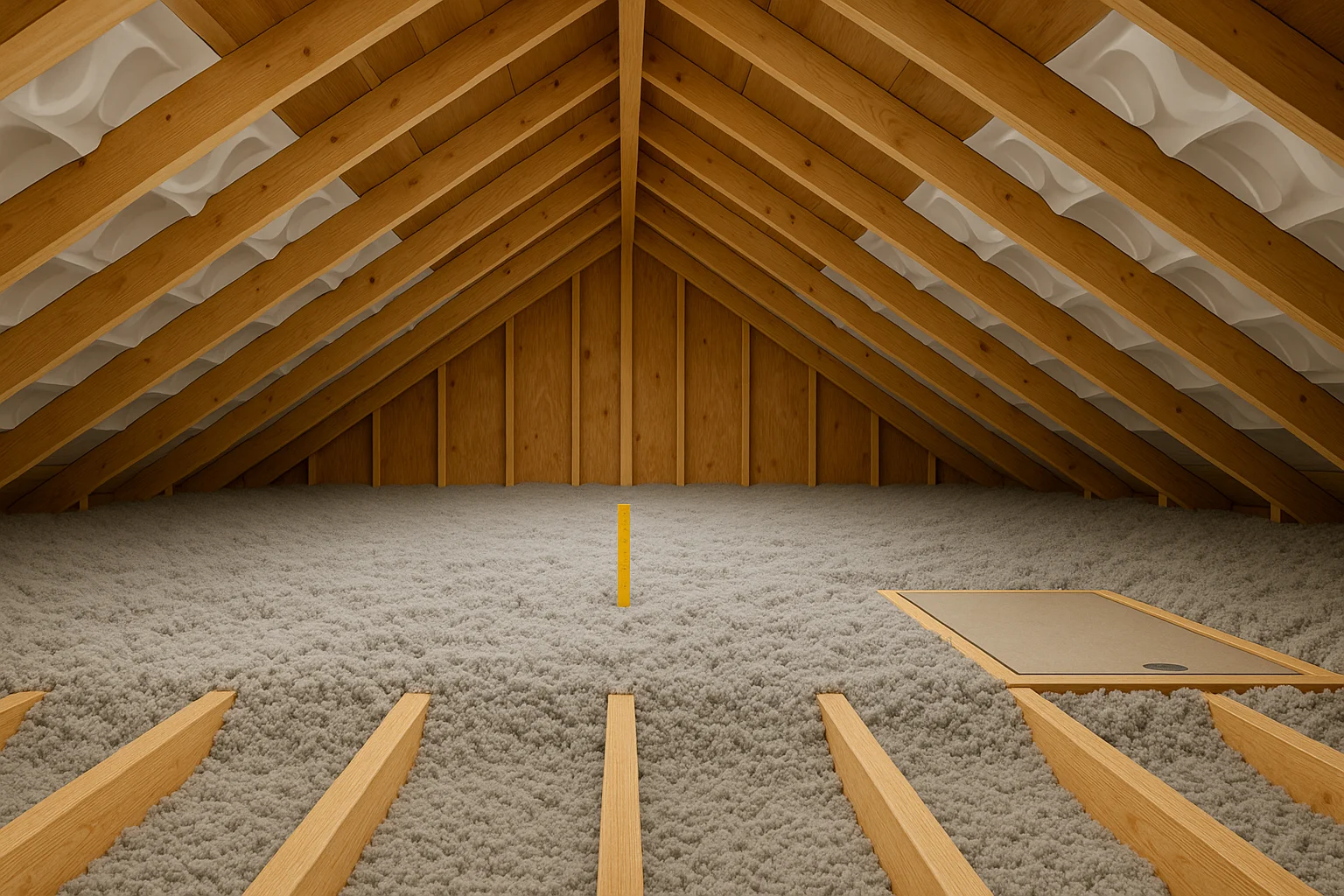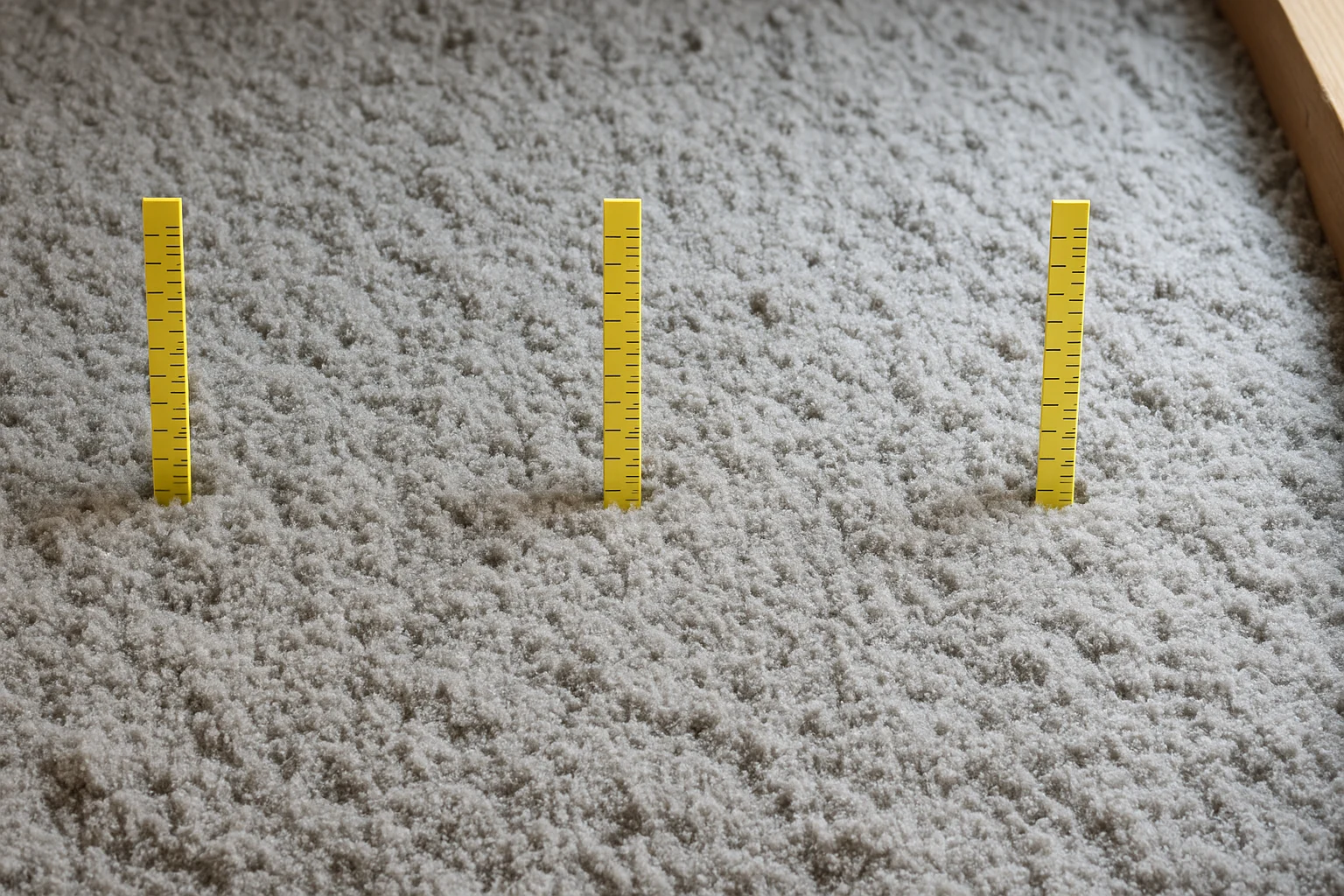
Energy bills keep climbing. The fastest fix most homes overlook is above your head. In this attic insulation DIY guide, you’ll assess your attic, hit the right R-value for your climate, seal big leaks, and install insulation safely—without overspending. Expect practical numbers, step-by-step actions, and clear safety cues you can follow in a single weekend. For the broader tax credits and rebates that can help fund this project, see energy efficient home improvement credits.
This page contains paid/affiliate links. As an Amazon Associate we earn from qualifying purchases, and we may earn commissions from other partners—at no extra cost to you. Links marked with ‘#ad’ are affiliate links, meaning we may earn a commission at no extra cost to you. Learn more.
Attic R-Value & Cost Estimator
Table of Contents
R-Value Targets by Climate
Quick R-value targets by climate (attic): Zones 1–3: R30–38 (~10–13 in fiberglass; 9–11 in cellulose). Zones 4–5: R38–60 (~13–20 in fiberglass; 11–16 in cellulose). Zones 6–8: R49–60 (~16–20 in fiberglass; 14–16 in cellulose). Subtract your current R (depth × per-inch value) to find what to add — and consider DIY window insulation as a companion project.
For official guidance and maps by zone, see the DOE insulation recommendations.
Attic Insulation DIY Costs & Payback — Cost Calculator
For a typical 1,000-sq-ft attic, plan on roughly $700–$1,800 DIY. That breaks down to fiberglass batts at $0.50–$1.20/sq ft or blown-in cellulose at $0.65–$1.50 (rentals are often $0–$75/day with purchase). Add baffles ($1–$3 each) plus foam/caulk and PPE. Many households can reduce HVAC energy use by 15–35%, so simple payback often falls in the 2–5 year range. Use the built-in attic insulation cost calculator above to estimate your range. If you’re price-comparing, “attic insulation cost home depot” searches give quick ballparks, but local promos vary.
Step-by-Step: Install Attic Insulation Safely
1) Assess current insulation
Measure depth in several spots and note material type. Multiply thickness by the per-inch R-value (fiberglass ~R-2.7–3.7; cellulose ~R-3.2–3.8) to estimate existing performance. Check for uneven coverage, compressed spots, and any signs of moisture. If your walls are under-insulated, see wall insulation DIY for options.
2) Air-seal big leaks first
Seal gaps around plumbing stacks, top-plate seams, electrical penetrations, and attic hatches with foam or caulk. Add weatherstripping to access doors. Install baffles at soffits to keep ventilation channels open. It’s the highest-ROI step in any attic DIY plan. For ducts specifically, see our DIY duct sealing & cleaning guide.
3) Plan safe clearances and moisture control
Follow code-safe clearances: keep insulation 3 in from non-IC recessed lights (or use IC-rated fixtures/boxes), and 3 in from metal flues/chimneys with sheet-metal flashing and fire-rated sealant. Maintain soffit airflow with baffles (1–2 in channel). In cold/mixed climates, place any vapor retarder on the warm-in-winter side; avoid double vapor barriers that trap moisture.
4) Add insulation — placing new insulation over existing
For batts, fit without compressing and cut around obstacles. If you’re wondering how to install attic insulation over existing material, set depth markers and blow evenly to the target height. Work from the farthest corner back to the hatch. Considering foam? Start with our DIY spray foam insulation guide.

5) Final checks
Verify depth against your zone target, confirm all baffles are clear, and ensure the attic hatch is insulated and weatherstripped.
My favorite low-effort hatch cover — a simple zip-open sleeve that helps cut drafts at the hatch.
Nice finishing touch after air-sealing: fits the frame and opens for easy access when you need it.
Common DIY Attic Insulation Mistakes
- Skipping air sealing before adding insulation in a do it yourself insulation attic project.
- Blocking soffit vents or covering baffles.
- Insulating hard against non-IC lights or hot flues.
- Underestimating depth to hit the correct R-value.
- Creating double vapor barriers that trap moisture.
Radiant Barriers (Hot Climates—Not a Substitute for R-Value)
Radiant barriers can lower attic temperatures in hot, sunny regions, improving comfort and reducing AC runtime. They do not replace required insulation; think of them as a supplement for sun-baked roofs. In cold climates, prioritize hitting the R-value targets above.
If you’re wondering “how often does attic insulation need to be replaced”, modern fiberglass and cellulose typically last for decades; replace sections only if they’ve been wet, moldy, pest-damaged, or heavily compressed, and re-fluff/level after any repairs.
Frequently Asked Questions
Conclusion
With an attic insulation DIY plan, you don’t need fancy tools to make a big dent in your energy bills—just a solid plan and a Saturday. Measure what you have, seal the leaks you can see, then add enough insulation to hit your climate’s target. Small, careful steps beat rushing every time.
If you’re unsure about clearances, moisture, or older materials, pause and check local code or bring in a pro for that piece. Otherwise, take it one zone at a time. Your future self (and your HVAC) will thank you.
- Next step, 10 minutes: Measure depth in three spots and note material.
- Next step, 1 hour: Air-seal around pipes, wires, and the attic hatch.
- Weekend win: Add insulation to reach your R-value target.
This guide is educational and general in nature. It is not tax or legal advice. Always follow local building codes and manufacturer instructions, wear appropriate PPE, and consult a qualified professional for electrical, structural, or combustion-clearance questions. Actual energy savings vary by climate, home leakage, and HVAC efficiency.